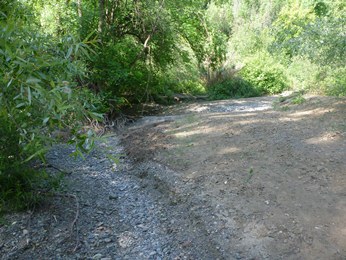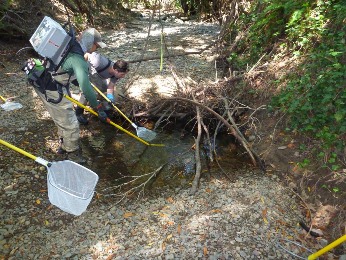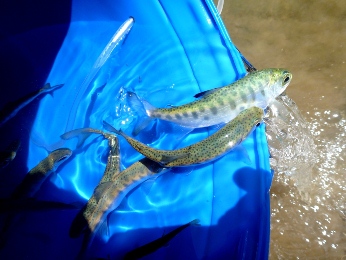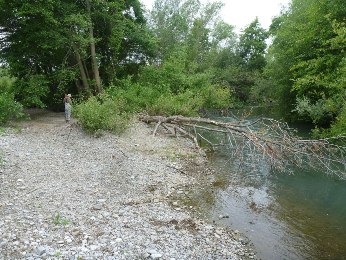Species Status
Coho salmon (Oncorhynchus kisutch) in the Central California Coast Evolutionarily Significant Unit (CCC ESU) are listed as endangered under the Federal Endangered Species Act (ESA) and the California Endangered Species Act (CESA). Some major human stresses contributing to recent and historic population declines include loss or degradation of habitat caused by dams, water diversions, marijuana cultivation, poor logging practices, agricultural land development and overfishing. Natural stress factors may include floods and droughts, poor ocean conditions, disease, predation, wildfires and poor water quality.
Since the initial federal listing in 1996, coho salmon populations have continued to decline. Under the ESA, the National Marine Fisheries Service (NMFS) developed and published the Recovery Plan for CCC ESU (PDF) in 2012. The plan covers the geographic area of the CCC which extends from Punta Gorda south to Aptos Creek in Santa Cruz County. The California Department of Fish and Wildlife (CDFW) published the Recovery Strategy for California Coho Salmon (PDF) in 2004 that addresses statewide recovery actions. Both documents provide guidance that focuses and prioritizes possible solutions to threats, and restoration actions needed for recovery of the species.
Today, the dramatic decline of coho populations in the CCC continues, exacerbated by drought conditions in the creeks in which they rear.
Necessity of Rescue
Many streams in the Russian River basin where natural-origin or hatchery-origin coho salmon occur are monitored for their coho population status and habitat conditions. The Russian River Coho Salmon Captive Broodstock Program (RRCSCBP) is an essential component of the species’ recovery. The University of California Cooperative Extension / CA Sea Grant (UCCE) is responsible for the monitoring component of the RRCSCBP. In addition, the Sonoma County Water Agency (SCWA), under a grant from the CDFW Fisheries Restoration Grant Program, implements the Coastal Salmonid Monitoring Program in the Russian River basin. Monitoring by both entities has been instrumental in responding to the continuing effects of persistent drought on habitat conditions in coho-bearing streams of the Russian River Watershed.
Since May 2015, CDFW regional staff captured and relocated juvenile coho salmon and other juvenile salmonids rearing in seven different streams in the Russian River basin. The primary motivation for these efforts was to facilitate outmigration of smolts that were trapped in disconnected and drying pools by capturing and relocating them to nearby Dry Creek or the mainstem Russian River (see map) so they may continue migration to the sea. Persistent drought conditions were placing juvenile salmonids in imminent danger of perishing due to rapidly drying habitat and associated deteriorating water quality and increased predation. In many instances, small pools where juvenile coho salmon are known to reside can dry up completely within a matter of a few days or even overnight (Figure 1).
 Figure 1: Dry Porter Creek where coho salmon smolts were rescued from drying pools.
Figure 1: Dry Porter Creek where coho salmon smolts were rescued from drying pools.
 Figure 2: Drying pool in Felta Creek, tributary to Russian River.
Figure 2: Drying pool in Felta Creek, tributary to Russian River.
Rescue Methods
All rescues were performed by electrofishing in combination with block nets (Figure 2). The map to the right illustrates coho salmon rescue and relocation sites in Felta, Pena, Mill, Porter Creeks and two unnamed tributaries to Green Valley Creek. The most recent rescues at Wine and Dutch Bill Creeks are not included in the map. All coho salmon smolts were relocated either into Dry Creek, a tributary to the Russian River with controlled year-round flows, or the mainstem of the Russian River. Steelhead trout and Chinook salmon were similarly relocated. All fish were acclimated to higher water temperatures before release if necessary. Young-of-the-year (YOY) coho salmon were transported to the Don Clausen/Warm Springs Fish Hatchery (WSFH) where they will be held, either as future broodstock for the RRCSCBP, or for release back into the streams of their origin when flows have improved. The vast majority (95%) of the rescued coho salmon smolts were of hatchery origin. This was evidenced by the presence of a coded wire tag (CWT) and, in approximately 15% of smolts, a passive integrated transponder (PIT) tag. Coho salmon originating from the RRCSCBP are marked with a PIT tag at a constant fraction of 15%. YOY coho salmon relocated to DCFH are held in quarantine and subjected to prophylactic disease treatment.
Mortalities were extremely low, including three coho salmon smolts, a fewYOY coho, and less than 0.1% of the more than 2,000 juvenile steelhead trout and Chinook salmon.
Results
Numbers of coho salmon, steelhead trout and Chinook salmon rescued and relocated from seven Russian River tributaries are shown in Table 1. Most of the coho smolts were hatchery-origin fish, and all coho YOY were of natural origin. The natural-origin coho YOY are of particular value to the RRCSCBP where some of them will be retained as future broodstock following genetic analysis to determine the degree of relatedness.
Table 1: Numbers of juvenile salmonids rescued and relocated. (*denotes streams not included in the map)
| |
Species and Life Stage |
| |
Coho Salmon |
Steelhead Trout |
Chinook Salmon |
| Stream |
Smolts |
YOY |
Smolts/Parr |
YOY |
Smolts |
YOY |
| Felta Creek |
32 |
76 |
21 |
0 |
0 |
0 |
| Pena Creek |
44 |
0 |
7 |
671 |
0 |
962 |
| Mill Creek |
206 |
0 |
1 |
129 |
0 |
0 |
| Porter Creek |
202 |
0 |
9 |
101 |
0 |
0 |
| Green Valley Creek |
111 |
167 |
4 |
19 |
0 |
0 |
| *Wine Creek |
12 |
81 |
28 |
159 |
0 |
0 |
| *Dutch Bill Creek |
21 |
111 |
7 |
40 |
0 |
0 |
| Total |
628 |
435 |
77 |
1,119 |
0 |
962 |
 Figure 3: Coho salmon smolts rescued from Pena Creek were released into the Russian River.
Figure 3: Coho salmon smolts rescued from Pena Creek were released into the Russian River.
 Figure 4: Dry Creek near the confluence of Mill Creek.
Figure 4: Dry Creek near the confluence of Mill Creek.
Monitoring
CDFW continues to monitor habitat conditions in selected Russian River tributaries to document the effects of the continuing drought. Based on these monitoring efforts, and surveys by UCCE/CA Sea Grant and SCWA, further coho salmon rescues may be performed throughout the summer.
Project Permitting
Fish rescues were performed under the authority of the Interagency Fish Rescue Policy, jointly signed by CDFW, NOAA Fisheries and USFWS.
References
California Department of Fish and Game. 2004. Recovery Strategy for California Coho Salmon. Report to the California Fish and Game Commission. 594 pp.
National Marine Fisheries Service. 2012. Final Recovery Plan for Central California Coast coho salmon Evolutionarily Significant Unit. National Marine Fisheries Service, Southwest Region, Santa Rosa, California.
CDFW
DCFH/U.S. Army Corps of Engineers